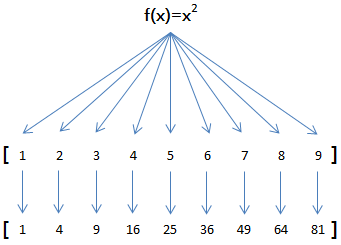Python内建了map()和reduce()函数。
如果你读过Google的那篇大名鼎鼎的论文“MapReduce: Simplified Data Processing on Large Clusters”,你就能大概明白map/reduce的概念。
我们先看map。map()函数接收两个参数,一个是函数,一个是序列,map将传入的函数依次作用到序列的每个元素,并把结果作为新的list返回。
举例说明,比如我们有一个函数f(x)=x2,要把这个函数作用在一个list [1, 2, 3, 4, 5, 6, 7, 8, 9]上,就可以用map()实现如下:

现在,我们用Python代码实现:
>>> def f(x): ... return x * x ... >>> map(f, [1, 2, 3, 4, 5, 6, 7, 8, 9]) [1, 4, 9, 16, 25, 36, 49, 64, 81]
map()传入的第一个参数是f,即函数对象本身。
你可能会想,不需要map()函数,写一个循环,也可以计算出结果:
L = [] for n in [1, 2, 3, 4, 5, 6, 7, 8, 9]: L.append(f(n)) print L
的确可以,但是,从上面的循环代码,能一眼看明白“把f(x)作用在list的每一个元素并把结果生成一个新的list”吗?
所以,map()作为高阶函数,事实上它把运算规则抽象了,因此,我们不但可以计算简单的f(x)=x2,还可以计算任意复杂的函数,比如,把这个list所有数字转为字符串:
>>> map(str, [1, 2, 3, 4, 5, 6, 7, 8, 9]) ['1', '2', '3', '4', '5', '6', '7', '8', '9']
只需要一行代码。
再看reduce的用法。reduce把一个函数作用在一个序列[x1, x2, x3...]上,这个函数必须接收两个参数,reduce把结果继续和序列的下一个元素做累积计算,其效果就是:
reduce(f, [x1, x2, x3, x4]) = f(f(f(x1, x2), x3), x4)
比方说对一个序列求和,就可以用reduce实现:
>>> def add(x, y): ... return x + y ... >>> reduce(add, [1, 3, 5, 7, 9]) 25
当然求和运算可以直接用Python内建函数sum(),没必要动用reduce。
但是如果要把序列[1, 3, 5, 7, 9]变换成整数13579,reduce就可以派上用场:
>>> def fn(x, y): ... return x * 10 + y ... >>> reduce(fn, [1, 3, 5, 7, 9]) 13579
这个例子本身没多大用处,但是,如果考虑到字符串str也是一个序列,对上面的例子稍加改动,配合map(),我们就可以写出把str转换为int的函数:
>>> def fn(x, y):
... return x * 10 + y
...
>>> def char2num(s):
... return {'0': 0, '1': 1, '2': 2, '3': 3, '4': 4, '5': 5, '6': 6, '7': 7, '8': 8, '9': 9}[s]
...
>>> reduce(fn, map(char2num, '13579'))
13579
整理成一个str2int的函数就是:
def str2int(s):
def fn(x, y):
return x * 10 + y
def char2num(s):
return {'0': 0, '1': 1, '2': 2, '3': 3, '4': 4, '5': 5, '6': 6, '7': 7, '8': 8, '9': 9}[s]
return reduce(fn, map(char2num, s))
还可以用lambda函数进一步简化成:
def char2num(s):
return {'0': 0, '1': 1, '2': 2, '3': 3, '4': 4, '5': 5, '6': 6, '7': 7, '8': 8, '9': 9}[s]
def str2int(s): return reduce(lambda x,y: x*10+y, map(char2num, s))
也就是说,假设Python没有提供int()函数,你完全可以自己写一个把字符串转化为整数的函数,而且只需要几行代码!
练习
利用map()函数,把用户输入的不规范的英文名字,变为首字母大写,其他小写的规范名字。输入:['adam', 'LISA', 'barT'],输出:['Adam', 'Lisa', 'Bart']。
Python提供的sum()函数可以接受一个list并求和,请编写一个prod()函数,可以接受一个list并利用reduce()求积。
 详细讲解Python之Seaborn(数据可视化)Apr 21, 2022 pm 06:08 PM
详细讲解Python之Seaborn(数据可视化)Apr 21, 2022 pm 06:08 PM本篇文章给大家带来了关于Python的相关知识,其中主要介绍了关于Seaborn的相关问题,包括了数据可视化处理的散点图、折线图、条形图等等内容,下面一起来看一下,希望对大家有帮助。
 详细了解Python进程池与进程锁May 10, 2022 pm 06:11 PM
详细了解Python进程池与进程锁May 10, 2022 pm 06:11 PM本篇文章给大家带来了关于Python的相关知识,其中主要介绍了关于进程池与进程锁的相关问题,包括进程池的创建模块,进程池函数等等内容,下面一起来看一下,希望对大家有帮助。
 Python自动化实践之筛选简历Jun 07, 2022 pm 06:59 PM
Python自动化实践之筛选简历Jun 07, 2022 pm 06:59 PM本篇文章给大家带来了关于Python的相关知识,其中主要介绍了关于简历筛选的相关问题,包括了定义 ReadDoc 类用以读取 word 文件以及定义 search_word 函数用以筛选的相关内容,下面一起来看一下,希望对大家有帮助。
 分享10款高效的VSCode插件,总有一款能够惊艳到你!!Mar 09, 2021 am 10:15 AM
分享10款高效的VSCode插件,总有一款能够惊艳到你!!Mar 09, 2021 am 10:15 AMVS Code的确是一款非常热门、有强大用户基础的一款开发工具。本文给大家介绍一下10款高效、好用的插件,能够让原本单薄的VS Code如虎添翼,开发效率顿时提升到一个新的阶段。
 Python数据类型详解之字符串、数字Apr 27, 2022 pm 07:27 PM
Python数据类型详解之字符串、数字Apr 27, 2022 pm 07:27 PM本篇文章给大家带来了关于Python的相关知识,其中主要介绍了关于数据类型之字符串、数字的相关问题,下面一起来看一下,希望对大家有帮助。
 详细介绍python的numpy模块May 19, 2022 am 11:43 AM
详细介绍python的numpy模块May 19, 2022 am 11:43 AM本篇文章给大家带来了关于Python的相关知识,其中主要介绍了关于numpy模块的相关问题,Numpy是Numerical Python extensions的缩写,字面意思是Python数值计算扩展,下面一起来看一下,希望对大家有帮助。
 python中文是什么意思Jun 24, 2019 pm 02:22 PM
python中文是什么意思Jun 24, 2019 pm 02:22 PMpythn的中文意思是巨蟒、蟒蛇。1989年圣诞节期间,Guido van Rossum在家闲的没事干,为了跟朋友庆祝圣诞节,决定发明一种全新的脚本语言。他很喜欢一个肥皂剧叫Monty Python,所以便把这门语言叫做python。


Hot AI Tools

Undresser.AI Undress
AI-powered app for creating realistic nude photos

AI Clothes Remover
Online AI tool for removing clothes from photos.

Undress AI Tool
Undress images for free

Clothoff.io
AI clothes remover

AI Hentai Generator
Generate AI Hentai for free.

Hot Article

Hot Tools

Notepad++7.3.1
Easy-to-use and free code editor

MantisBT
Mantis is an easy-to-deploy web-based defect tracking tool designed to aid in product defect tracking. It requires PHP, MySQL and a web server. Check out our demo and hosting services.

DVWA
Damn Vulnerable Web App (DVWA) is a PHP/MySQL web application that is very vulnerable. Its main goals are to be an aid for security professionals to test their skills and tools in a legal environment, to help web developers better understand the process of securing web applications, and to help teachers/students teach/learn in a classroom environment Web application security. The goal of DVWA is to practice some of the most common web vulnerabilities through a simple and straightforward interface, with varying degrees of difficulty. Please note that this software

EditPlus Chinese cracked version
Small size, syntax highlighting, does not support code prompt function

SublimeText3 Linux new version
SublimeText3 Linux latest version







